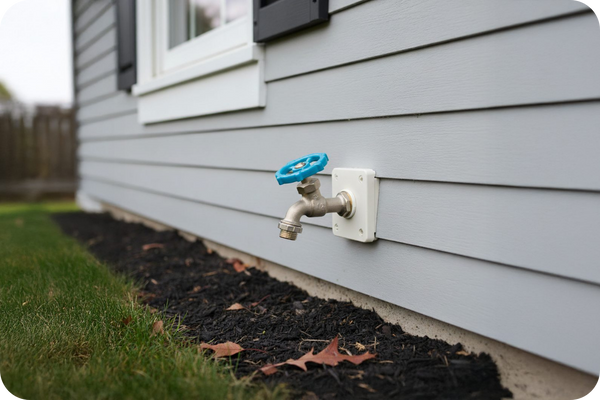How to Winterize an Outside Faucet
As fall deepens and the evenings grow colder, it’s smart to get ahead of winter’s chill. One simple yet critical maintenance task is to protect your outdoor faucets from freezing. A frozen hose bib (that’s the fancy name for your outdoor spigot) can crack pipes, cause leaks, or lead to costly water damage. Fortunately, with a few careful steps now, you can avoid those headaches later.
Step 1: Disconnect and Drain Hoses
Remove any garden hoses or attachments from your outdoor faucets. Shake out remaining water and store hoses in a dry place. Leaving water in the hose or faucet leaves the door open for expansion and rupture when freezing hits. According to Family Handyman, turning off outdoor faucets, opening them, and draining excess water is a key part of plumbing winterization.
Step 2: Turn Off Interior Shut‑Off Valve and Drain
Inside your home (often in the basement, crawl space or utility area), there’s usually a shut-off valve for the outdoor faucet line. Close it fully. Then go back outside and open the faucet so that any water left in the line can drain out. This practice is recommended by multiple plumbing resources as essential to prevent freeze damage, including this Family Handyman guide.
Step 3: Insulate the Faucet
Even after draining, your faucet shell is exposed to cold air. Use a foam faucet cover (available at hardware stores) to wrap it. You can also use a rag or towel as an extra layer. The Portland Water Bureau recommends insulating all outdoor faucets using molded‑foam covers or protective wraps.
Step 4: Consider Upgrading to Frost‑Free Faucets
In homes with older plumbing, faucets may put the valve close to exterior frost zones. A frost‑free or freeze‑proof faucet keeps the shut‑off deeper inside the wall where it stays warmer. Even with those, basic winterization is still wise as a backup. Many plumbing guides treat frost‑free as a helpful upgrade, not a complete substitute.
Step 5: Don’t Forget Sprinklers & Other Exterior Water Lines
Outdoor faucets aren’t the only vulnerable water lines. If you have an irrigation or sprinkler system, blow out or drain it before freezing weather sets in. Exterior Medics provides a good overview of how to winterize both faucets and sprinkler systems.
Wrapping Up
Spending 15 or 20 minutes this fall to winterize your exterior faucets can save you hundreds or even thousands in plumbing repairs. As someone who lives and works in Fredericksburg, I’ve seen how small preventative tasks protect a home’s value and spare stress. If you want help building a seasonal maintenance checklist tailored to homes in our region, I’d be happy to help.
For more local homeowner tips, visit FredericksburgNow.com.

 Facebook
Facebook
 X
X
 Pinterest
Pinterest
 Copy Link
Copy Link


